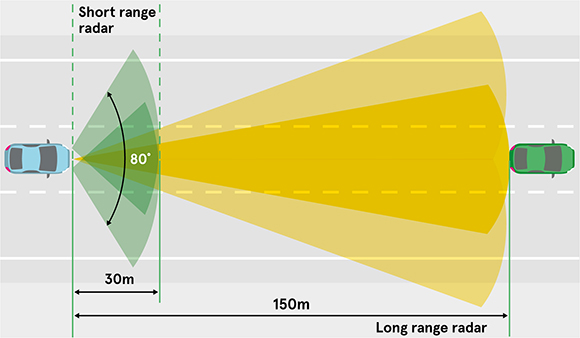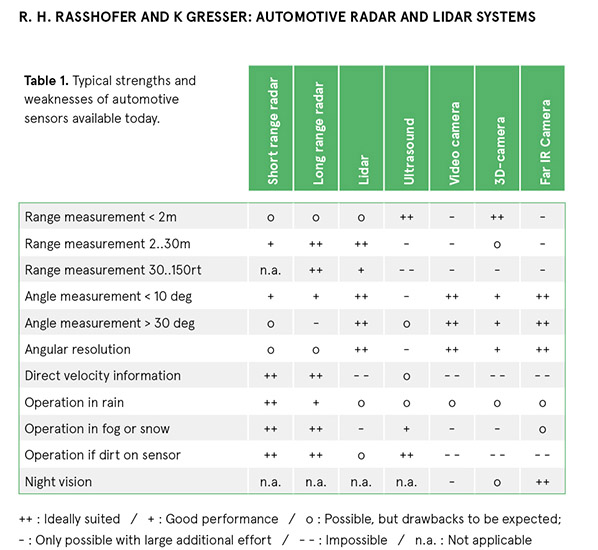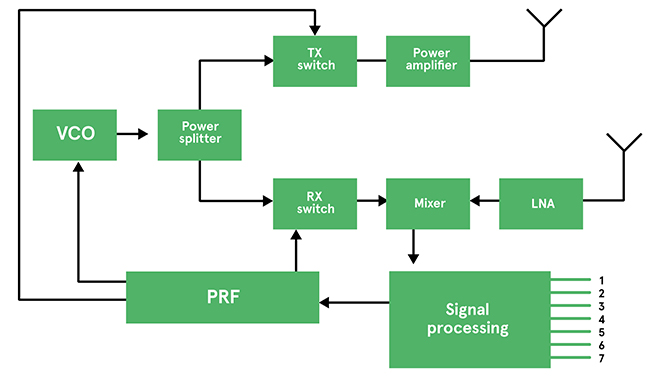Automotive radar systems: the design engineer’s guide
The need for advanced driver assistance
According to research by the NHTSA, the leading cause of road accidents is the driver of the vehicle, either through inattention or error of judgment. In fact, this has been identified as the cause of over 90% of all accidents. As a result, automakers are seeking ways to remove the reliance on the driver as the primary decision maker, driven by a desire to make roads safer and the need to comply with increasingly stringent legislation.
Advanced driver assistance systems (ADAS) are increasing in popularity, and while many think they are entirely new, this is not the case. Systems such as traction control, stability control and anti-lock braking all form part of ADAS, are relatively common and have been so for years.
However, where there is a significant change is that ADAS systems are now rapidly moving towards becoming aware of the environment around the vehicle and assisting the driver in avoiding obstacles, both static and mobile.
At the heart of this are vision systems that use a variety of technologies including semiconductor-based vision sensors, light-based LIDAR and radio-based radar.
Six levels of driving automation
As vehicles move towards semi and eventually full autonomy, the technology is following a path that has been clearly defined by the US Society of Automotive Engineers (SAE). The model defines six levels where the least level of automation is Level 0. This represents no automation at all, with driving relying solely on the driver. The majority of vehicles are currently included in this level. The next levels (1 and 2) include some ADAS features such as automated emergency braking (AEB), lane keeping assist (LKA), adaptive cruise control (ACC) and stability control. In the SAE model, Level 1 is where a single system operates in isolation while Level 2 is reached when systems can operate together. Regulators are recognising the importance of these systems and several are saying they will not issue a 4- or 5-star safety rating unless they are present.
At Level 3, vehicles can operate autonomously in less complex and challenging environments, including highways without pedestrians or difficult intersections, and where all the vehicles travel in the same direction at around the same speed. In this scenario, the driver only needs to monitor the progress and operation of the vehicle, being ready to resume control instantly if the situation dictates.
Full autonomy is covered by the highest levels, 4 and 5. Fully autonomous operation is possible in all conditions and the driver becomes a passenger, with no need for intervention.
In a Level 4 vehicle, the pedals and other controls remain, allowing manual driving if desired. Level 5 vehicles, however, have no controls at all and are essentially a ‘box on wheels’.
Autonomous vehicles drive technology forward
Creating vehicles that can drive fully autonomously is one of the greatest challenges that automakers have ever faced. Not only does it push forward the need for vision systems, but also has an impact on the fundamental architecture of the vehicle.
The volume and speed of data within the vehicle is increasing dramatically, especially with the introduction of vision sensors. As ADAS systems rely on some types of data to make their decisions, it’s important this safety-critical information is not delayed by other less-critical data. To address this, a modified version of Ethernet that eliminates the random access CSMA/CD and provides deterministic / time sensitive operation has been developed. Automotive Ethernet can handle data rates of gigabits per second and is able to ensure rapid propagation of safety-critical traffic in preference to less important information.
Automotive radar
 Figure 1: A typical automotive radar system will have different elements to cover different ranges |
Radar is an essential element of ADAS systems and is often used in conjunction with other systems including LIDAR, vision sensors and ultrasonics. Combining these technologies via sensor fusion allows each system to work to their strengths and provides resilience and confirmation.
Typically, three types of radar will be found in an ADAS system,: long-range radar (LRR) is capable of detection at distances up to 250 metres, while medium-range radar (MRR) operates in the 1-60 metres range and short-range radar (SRR) covers the 1-30 metres range – useful for applications such as blind-spot detection, lane change assistance, parking aids etc.
Radar sensors are generally mounted to all four sides (front, rear, left and right) of a vehicle. The operating frequency used initially was 24GHz although this is now being superseded by 77GHz solutions. The 77GHz system (including major components and antennas) is much smaller and the detection range and resolution is better than the 24GHz alternative.
Two types of radar are commonly used. Pulse-Doppler radar sends out a short pulse with high peak power at regular intervals, known as the pulse repetition interval (PRI). In these systems – often called half-duplex – after the transmitter has sent the pulses it is turned off and the receiver is activated. The receiver is activated and measures the time-of-flight (TOF) by which the distance of the reflecting object can be calculated.
Additionally, if the phase shift between multiple pulses is measured using the Doppler Effect, the relative velocity of the reflecting object can be calculated and, because the ADAS system knows the velocity of the vehicle with the radar sensor mounted, the absolute velocity of the object is easily deduced. Pulse-Doppler systems are best suited to longer-range use due to the slight delay between switching off the transmitter and activating the receiver.
In common with LIDAR, radar can also operate in frequency modulated continuous wave (FMCW) mode. Instead of using pulses, here the transmission is continuous but the frequency of the transmitted wave is swept across part of the allocated bandwidth. These ‘chirps’ are characterised by the start frequency, duration and bandwidth. FMCW systems have physically separate transmitters and receivers to prevent interference between the transmitted chirp and the echo signals.
 Figure 2: Comparison of the various ADAS-related detection systems |
A comparison of the various technologies
While several technologies exist for monitoring the environment around a vehicle, one technology will generally be most suitable for a particular application. However, although it’s not ideal, many technologies can perform adequately in several applications, allowing for sensor fusion where one measuring system enhances or validates what another system is seeing.
Not only is this important from a safety perspective to eliminate false or erroneous assumptions by the ADAS system, it also provides a level of redundancy should one particular system (or part of it) fail.
From the table above, it can be seen that radar is particularly valuable in medium- to long-range measurement and, unlike LIDAR, is able to perform well in poor weather conditions such as rain, fog and snow. LIDAR, however, generally outperforms radar in angular measurement which allows the shape of objects to be deduced.
The passive and connectivity challenge
With radar, while much of the focus is often on the semiconductors, the passive elements of the system are critically important in ensuring the reliable and accurate operation that must be achieved for these safety-critical systems. In particular, the transmit and receive sections of radar systems have a heavy analogue content and passive components are particularly important here, as well as providing filtering throughout the system.
 Figure 3: Block diagram of an automotive radar implementation |
In common with almost every automotive application, components for radar applications need to be able to deal with the stresses of the automotive environment, including shock and vibration. While they may not be subject to elevated temperatures found inside the vehicle, as they are mounted externally, they will be subject to the extremes of the ambient temperatures that the vehicle is operated in.
With the ever-increasing use of electronics in vehicles, manufacturers are developing and adapting components to be suited to the stringent need of the automotive market. In part, this can be achieved by submitting them for automotive-related approvals such as AEC-Q200 and similar.
With the importance of EMI suppression in automotive applications, especially those with an analogue portion such as radar, automotive-grade capacitors are particularly useful to designers. One example is a metallised polypropylene film EMI suppression capacitor that offers values up to 4.7uF in a self-extinguishing UL 94V-0 package. These devices are specifically intended for use in automotive applications and have been subjected to AEC-Q200 testing. In addition, the devices are subjected to a 100% factory screening at 1900 VDC to meet the requirements of all applications. After the Hi-Pot test, all electrical characteristics are re-checked to confirm correct operation without a parametric shift.
Summary
Radar is an essential part of modern ADAS systems, especially as it can to operate effectively over long distances and in poor weather conditions. As vehicles and drivers become more dependent reliant (and eventually wholly dependent) upon ADAS systems, the reliability of these radar systems has never been more important.
Component manufacturers are recognising the importance of these systems, as well as the rapidly growing market opportunity in automotive, and many new components specifically intended for automotive use are becoming available.
Below we’ve highlighted our leading suppliers for components suited to automotive radar systems.
If you require advice on selecting the right components for your design, our technical specialists are on hand to help.
Applications
- Powertrain and EV/HC/PHEVs
- Comfort, infotainment and safety
- Communications and connectivity
- Lighting
Engineering Services
Ready to start the engine of your automotive design?
Our automotive specialists are on hand to provide technical and product support you need.

Focus magazine
Automotive design: accelerating innovation
This edition of Focus magazine addresses these challenges from each perspective.
